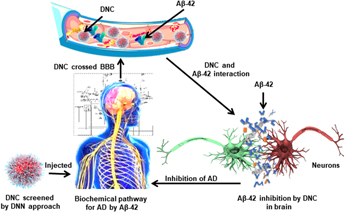Crossref Citations
This article has been cited by the following publications. This list is generated based on data provided by
Crossref.
Kaushik, Aman Chandra
Gautam, Deeksha
Nangraj, Asma Sindhoo
Wei, Dong-Qing
and
Sahi, Shakti
2019.
Protection of Primary Dopaminergic Midbrain Neurons Through Impact of Small Molecules Using Virtual Screening of GPR139 Supported by Molecular Dynamic Simulation and Systems Biology.
Interdisciplinary Sciences: Computational Life Sciences,
Vol. 11,
Issue. 2,
p.
247.
Kanchi, Pavan Krishna
and
Dasmahapatra, Ashok Kumar
2019.
Polyproline chains destabilize the Alzheimer’s amyloid-β protofibrils: A molecular dynamics simulation study.
Journal of Molecular Graphics and Modelling,
Vol. 93,
Issue. ,
p.
107456.
Kaushik, Aman Chandra
Kumar, Ajay
Yu, Chun-Yen
Kuo, Shiao-Wei
Liang, Shih-Shin
Singh, Satya P.
Wang, Xiangeng
Wang, Yan-Jing
Yen, Chung-Kun
Dai, Xiaofeng
Wei, Dong-Qing
Pan, Cheng-Tang
and
Shiue, Yow-Ling
2019.
PCL–DOX microdroplets: an evaluation of the enhanced intracellular delivery of doxorubicin in metastatic cancer cells via in silico and in vitro approaches.
New Journal of Chemistry,
Vol. 43,
Issue. 31,
p.
12241.
Srivastav, Saurabh
Anand, Bibin G.
Fatima, Mahino
Prajapati, Kailash P.
Yadav, Suresh Singh
Kar, Karunakar
and
Mondal, Amal Chandra
2020.
Piperine-Coated Gold Nanoparticles Alleviate Paraquat-Induced Neurotoxicity in Drosophila melanogaster.
ACS Chemical Neuroscience,
Vol. 11,
Issue. 22,
p.
3772.
Moayeri, Ardeshir
Darvishi, Marzieh
and
Amraei, Mansour
2020.
<p>Homing of Super Paramagnetic Iron Oxide Nanoparticles (SPIONs) Labeled Adipose-Derived Stem Cells by Magnetic Attraction in a Rat Model of Parkinson’s Disease</p>.
International Journal of Nanomedicine,
Vol. Volume 15,
Issue. ,
p.
1297.
Kaur, Amandeep
Kaur, Anupamjeet
Goyal, Deepti
and
Goyal, Bhupesh
2020.
How Does the Mono-Triazole Derivative Modulate Aβ42 Aggregation and Disrupt a Protofibril Structure: Insights from Molecular Dynamics Simulations.
ACS Omega,
Vol. 5,
Issue. 25,
p.
15606.
Bera, Kaushik
Mondal, Animesh
Pal, Uttam
and
Maiti, Nakul C.
2020.
Porphyrin-Armored Gold Nanospheres Modulate the Secondary Structure of α-Synuclein and Arrest Its Fibrillation.
The Journal of Physical Chemistry C,
Vol. 124,
Issue. 11,
p.
6418.
Kumar, Ajay
Chaudhary, Ravi Kumar
Singh, Rachita
Singh, Satya P.
Wang, Shao-Yu
Hoe, Zheng-Yu
Pan, Cheng-Tang
Shiue, Yow-Ling
Wei, Dong-Qing
Kaushik, Aman Chandra
and
Dai, Xiaofeng
2020.
Nanotheranostic Applications for Detection and Targeting Neurodegenerative Diseases.
Frontiers in Neuroscience,
Vol. 14,
Issue. ,
Saravanan, Konda Mani
Zhang, Haiping
Zhang, Huiling
Xi, Wenhui
and
Wei, Yanjie
2020.
On the Conformational Dynamics of β-Amyloid Forming Peptides: A Computational Perspective.
Frontiers in Bioengineering and Biotechnology,
Vol. 8,
Issue. ,
Abbas, Mohamed
2021.
Potential Role of Nanoparticles in Treating the Accumulation of Amyloid-Beta Peptide in Alzheimer’s Patients.
Polymers,
Vol. 13,
Issue. 7,
p.
1051.
Khan, Nazeer Hussain
Mir, Maria
Ngowi, Ebenezeri Erasto
Zafar, Ujala
Khakwani, Muhammad Mahtab Aslam Khan
Khattak, Saadullah
Zhai, Yuan-Kun
Jiang, En-She
Zheng, Meng
Duan, Shao-Feng
Wei, Jian-She
Wu, Dong-Dong
and
Ji, Xin-Ying
2021.
Nanomedicine: A Promising Way to Manage Alzheimer’s Disease.
Frontiers in Bioengineering and Biotechnology,
Vol. 9,
Issue. ,
Welch, E. Celeste
Powell, Jessica M.
Clevinger, Tobias B.
Fairman, Alexis E.
and
Shukla, Anita
2021.
Advances in Biosensors and Diagnostic Technologies Using Nanostructures and Nanomaterials.
Advanced Functional Materials,
Vol. 31,
Issue. 44,
Kaur, Rajdeep
Kaur Saini, Rajneet
Singh, Pritpal
and
Goyal, Bhupesh
2021.
Unveiling the inhibitory mechanism of peptidomimetic inhibitor against Aβ42 aggregation and protofibril disaggregation by molecular dynamics.
Journal of Molecular Liquids,
Vol. 335,
Issue. ,
p.
116474.
Bashir, Waleed
and
Shahzadi, Sana
2022.
Nanoparticles – a novel theranostic approach to treat alzheimer’s disease.
Journal of Applied Biotechnology & Bioengineering,
Vol. 9,
Issue. 6,
p.
216.
Bhattacharya, Tanima
Soares, Giselle Amanda Borges e
Chopra, Hitesh
Rahman, Md. Mominur
Hasan, Ziaul
Swain, Shasank S.
and
Cavalu, Simona
2022.
Applications of Phyto-Nanotechnology for the Treatment of Neurodegenerative Disorders.
Materials,
Vol. 15,
Issue. 3,
p.
804.
Singh, Kamaljot
Kaur, Anupamjeet
Goyal, Deepti
and
Goyal, Bhupesh
2022.
Mechanistic insights into the mitigation of Aβ aggregation and protofibril destabilization by ad-enantiomeric decapeptide rk10.
Physical Chemistry Chemical Physics,
Vol. 24,
Issue. 36,
p.
21975.
Kanojia, Neha
Thapa, Komal
Kaur, Gagandeep
Sharma, Ameya
Puri, Vivek
and
Verma, Nitin
2023.
Update on Therapeutic potential of emerging nanoformulations of phytocompounds in Alzheimer's and Parkinson's disease.
Journal of Drug Delivery Science and Technology,
Vol. 79,
Issue. ,
p.
104074.
Zhang, Wenli
Li, Yifan
Ren, Wentao
and
Liu, Bo
2023.
Artificial intelligence technology in Alzheimer's disease research.
Intractable & Rare Diseases Research,
Vol. 12,
Issue. 4,
p.
208.
Thukral, Prachi
Chowdhury, Ruchita
Sable, Harsh
Kaushik, Ajeet
and
Chaudhary, Vishal
2023.
Sustainable green synthesized nanoparticles for neurodegenerative diseases diagnosis and treatment.
Materials Today: Proceedings,
Vol. 73,
Issue. ,
p.
323.
Maisam, Muhammad
Khan, Muhammad Tahir
Lodhi, Madeeha Shahzad
Mou, Kejie
Liu, Zili
and
Wei, Dongqing
2023.
Alzheimer's Disease; Mechanism, Mutations, and Applications of Nano-Medicine.
Frontiers in Bioscience-Landmark,
Vol. 28,
Issue. 10,



